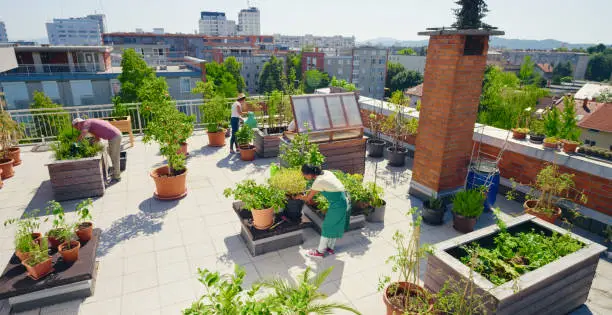This article explores various solutions related to food production in an urban environment, about the benefits it brings to people and communities
Recently, the process or concept of urban gardening has gained much interest to help cities continue sustaining and continuing to attract more and more members of the human race with the demand for available fresh, locally grown produce. Urban agriculture addresses three major concerns: food deserts, environmental issues, and the growing separation between people and their sources of food. Replace grey concrete and iron with productive greenery in cities for sustainability, self-sufficiency, and resilience.
The Need for Urban Gardening
These days, urbanization has become a fact of the world; by now over half of the world's population live in cities. With this process come a number of challenges, among which is increased pressure on food systems. Most urban areas have also been sited quite far from conventional farming regions, which results in increasingly long food supply chains that are prone to disruption. Other examples include the proliferation of food deserts, which serve to widen health disparities.
Such challenges can be complemented by urban gardening, which can situate food production closer to the consumer. Growing food in urban areas reduces reliance on extended supply chains, cuts carbon emissions, and supplies the community with more fresh foods. Besides, urban gardening creates a link between people and their food, promoting healthier eating behavior and respect for the environment.
Types of Solutions for Urban Gardening
Depending on the available space, resources, and the intent of the gardeners, urban gardening takes a lot of forms. The list below comprises some of the most common and innovative solutions for food growing in a city.
1. Container Gardening
Container gardening is the easiest and most available form of urban gardening. This system of plant growth can come in potted or bucket forms and is one of the ideal kinds of gardening for the kind of people who had limited spaces, such as apartment dwellers or people with small yards. Containers can be stationed on balconies, rooftops, window sills, or any other space available with adequate sunlight.
One of the prime advantages to container gardening is the flexibility one has. For one thing, gardeners are able to move containers to maximize sun, to protect plants from weather conditions, or take advantage of another design option for the garden. Another advantage with container gardening is that it often offers the chance to create superior soil quality, drainage, and pest management.
Tips for Successful Container Gardening:
- Preparation of the right container: Containers are selected in a way that they can hold the root system of the plant one desires to grow. They must have drainage holes so that waterlogging does not take place.
- Selecting the appropriate soil: One should opt for a very good potting mix that offers the requisite nutrients and proper drainage. Garden soil should not be used because it does not drain well in containers.
- Variety of Plant: Select the dwarf or compact varieties of vegetables and herbs that give their best for the container system of cultivation. Tomatoes, peppers, lettuce, and herbs like basil and mint are some varieties in great demand.
2. Raised Bed Gardening
Raised bed gardening is a form of gardening that involves the creation of above-the-ground garden beds, normally framed with wood or stone, among other materials. A raised bed will just be perfect for urban areas that may have poor quality soil and space limitations. They will allow better control over the condition of the soil and the improvement of drainage with reduced risk of soil compaction.
Their appearance can vary from very small to vast enough for community gardens. Really, this is the charm about raised beds, isn't it? For an urban setting, where the soil, being in a city, is likely contaminated, this is what one has to do to be on the safe side of things. This danger of getting your plants in touch with contaminated ground soil is taken away.
Benefits of raised bed gardening
- Better soil quality:Raised beds allow the gardeners to fill them up with the best quality of soil and compost in the right amount, ideal for plant growth.
- Better drainage: Whatever the added cost might be, raised beds are better drained compared to traditionally grown gardens.
- Accessibility:Generally, these raised beds are made at a particular height which doesn't require excessive bending or too much kneeling, therefore it becomes manageable for those with disabilities to be a gardener.
3. Vertical Gardening
This is in line with vertical gardening, where the plants grow up instead of out. This is quite an ideal technique for urban gardens where horizontal space can be extremely limited. Aside from the use of a trellis, achieving vertical gardens can be made possible by using wall-mounted planters, hanging baskets, and veritable vertical gardening systems.
It is very well performed on beans, peas, cucumbers, and some types of squash which are vining. It also applies to herbs, leafy greens, and even strawberries. Apart from the optimization of space, the vertical gardens can also serve to become decorative elements, adding greenery in urban landscapes.
Unique Ideas for Vertical Gardening:
- Vertical wall greening structures: This is a structure of a vertical wall covered with vegetation. Installations of green walls may be done within or outside the building edifices to function as insulations and cause energy efficiency, something that's so important in indoor air quality provisions.
- Pallet gardens: A pallet garden is one such creative example of utility in vertical gardening. By constructing a pallet garden, all you need to do is fill it with topsoil, plant your seeds or seedlings, and lean it against a wall or even a fence.
- Hanging planters: They can be suspended from ceilings, balconies, or even fences, which would allow the plants to cascade downwards and utilize the vertical space well.
4. Rooftop Gardening
Rooftop gardening refers to the process of growing plants on the upper platforms of structures and is quite prevalent today in highly populous areas. Typically, rooftops are well-endowed with enough sunlight availability and can always be converted into a fruitful area of garden space with the facilitation of relevant structural build-up. Rooftop gardens may range in size, on the other hand, from a small personal plot up to a big commercial farm.
There are mainly two types of rooftop gardens: intensive and extensive rooftop gardens. The intensive rooftop garden resembles any typical garden with deep soil and manifold choices of plants, which range from vegetables to fruits and even shrubs. By contrast, an extensive rooftop garden is shallow-soiled, most often planted with no-care vegetation like grasses, succulents, and herbs.
Advantages of rooftop gardening
- Space maximization: Most urban rooftops are barely used; hence, rooftop gardens can be considered well located on rooftops.
- Building efficiency: Insulation to buildings can be availed by rooftop gardens which result in a reduction in the cost of heating and cooling.
- Stormwater management: Rooftop gardens have the ability to soak rainwater. This limits the runoff and in turn limits urban flooding.
5.Community gardens
These gardens are spaces where people congregate for food production. The common places for the gardens include parks, lots, and school grounds. Benefits derived from community gardening will include enhancement of social networks, consumption of more fresh produce, and care for the environment.
The other way of helping in ameliorating food insecurity could be community gardens in the cities. In this way, residents are given a chance to grow their food on their own and thereby avail space to them. They act as a forum for learning about gardening, nutrition, and environmental sustainability.
Starting a Community Garden:
- Location:A decision needs to be made on what piece of land the garden shall be placed or permission sought from the owner or local government.
- Form a group:Organize a group of interested people that can give time, materials, and labor to the garden.
- Create a plan:Give your garden a plan which is going to stipulate what the layout will look like, what kinds of plants to grow, and what roles and responsibilities the participants have in it.
- Seek out funding and materials:Writing grants, soliciting donations, and holding numerous fundraisers to help finance the materials, equipment, and seeds.
6.Hydroponics and Aquaponics
So far, the cultivation in the absence of soil-also better known as hydroponics and/or aquaponics-goes great within the general framework of urban farming techniques. In hydroponics, plants grow in intensified, aqueous, fortified solutions of nutrients; actually this is a version in this kind of setup. Aquaponics is a methodology for the cultivation of plants in which the process works by combining hydroponics and aquaculture, thereby using fish waste for fertilization in the process of plant cultivation.
These are very efficient systems where less water is used when compared to the conventional means of gardening. Food can be produced throughout the year because the environment will be controlled. These systems can be used on basements, rooftops, or indoors and are very space-efficient; hence they are most ideal for urban settings.
Hydroponics and Aquaponics Advantages:
- Space Efficiency: They can be packed in a row, so their potential to boost space efficiency is achieved through the use of minimum space.
- Water consumption: Hydroponic and aquaponic methods use approximately 90% less water compared to the traditional soil based gardening method.
- Speed of growth: Plants under hydroponic and aquaponic setups often grow faster due to the optimized growing conditions with higher yields.
Benefits of Urban Gardening
Advantages accompanying urban gardening are many-to the benefit of a person and the community at large. More than being production grounds, benefits related to food production are also extended towards environmental sustainability, social welfare, and economic stability.
Environmental Benefits
Urban gardens amplify the call for environmental sustainability. It would reduce the carbon footprint of a city, not spending too much energy on transportation, storage, and packaging. Besides, it can soften the urban heat island effect caused by a sea of concrete landscaping.
It also increases biodiversity by giving space for pollinators, birds, and wildlife. It filters the air from contaminants and increases the level of oxygen around it. Moreover, urban gardening helps with water management in finding sustainable ways of rainwater harvesting and drip irrigation among others.
Health Benefits
Some of the major health benefits that can be acquired from urban gardening include fresh and healthy foodstuffs. Urban gardens have been able to provide vital fruits and vegetables, especially in areas identified as food deserts. This helps in curbing problems of dieting experiences that come with diseases such as obesity, diabetes, and heart disease.
Gardening in turn is a healthy activity that adds to physical activity, reduces stress, and improves mental well-being. The care for plants and outdoors has been associated with lower levels of cortisol, improved mood, and enhanced quality of life.
Social Benefits
Urban gardens are seen to build community and social cohesion. Community gardens, in particular, put together individuals of diverse backgrounds and allow them to interact socially, cooperate with one another, and even be in a position to support each other. This may also develop into areas of cultural exchange when different participants share various ways of gardening, recipes, and traditions.
Conclusion
Urban gardening is a very practical and sustainable solution for growing food in the city because of confined space, with very limited access to fresh produce. Innovative vertical gardens, rooftop farms, and plots for communal city gardening enable inhabitants to grow their own food, reduce the carbon footprint, and bring them closer to nature. In this way, the movement contributes not only to food security but also to the social tissue of urban communities. Thus, the necessity for further urban development opens up new opportunities for embracing urban gardening in greener, healthier, and more resilient environmental goals.


























